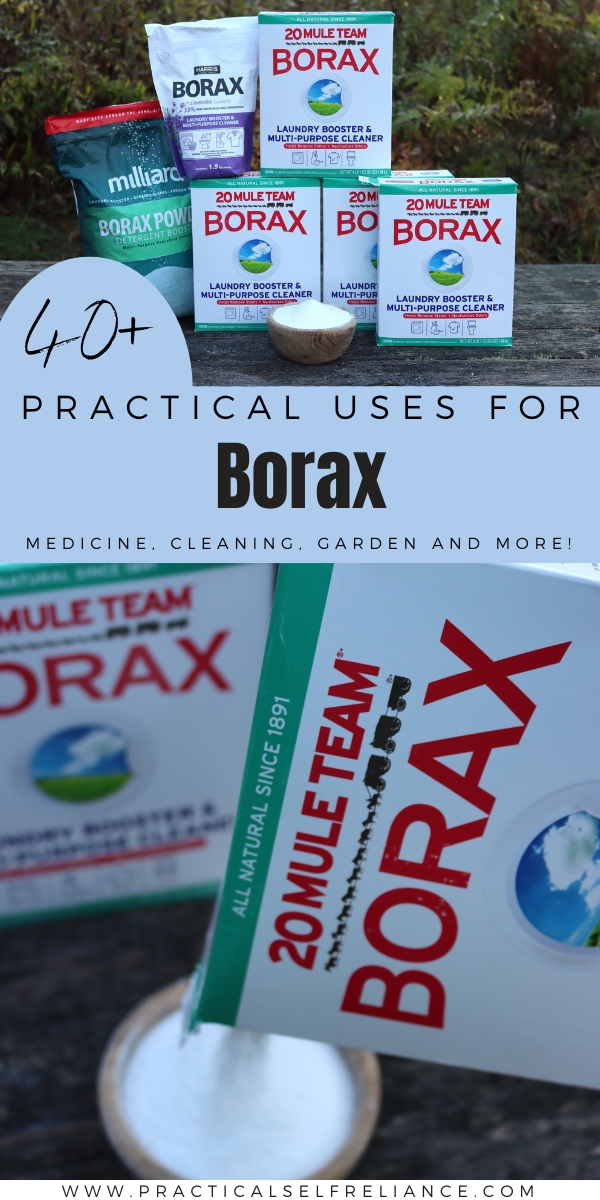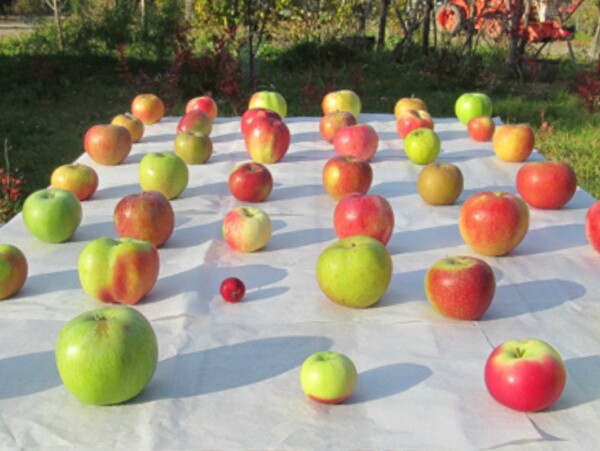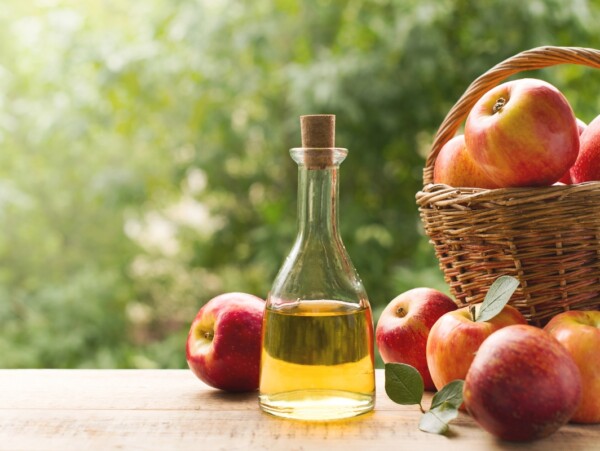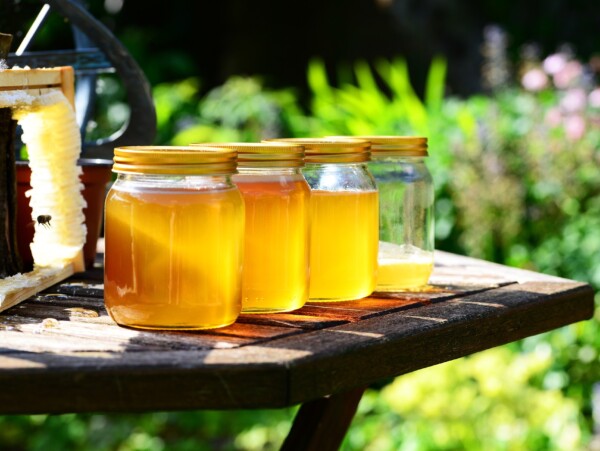Affiliate disclosure: This post may contain affiliate links. Please see our Privacy Policy.
Borax can be used for an incredible number of things around the home and garden. It was once a staple in every home, and it’s still useful for many things that just won’t work without it.
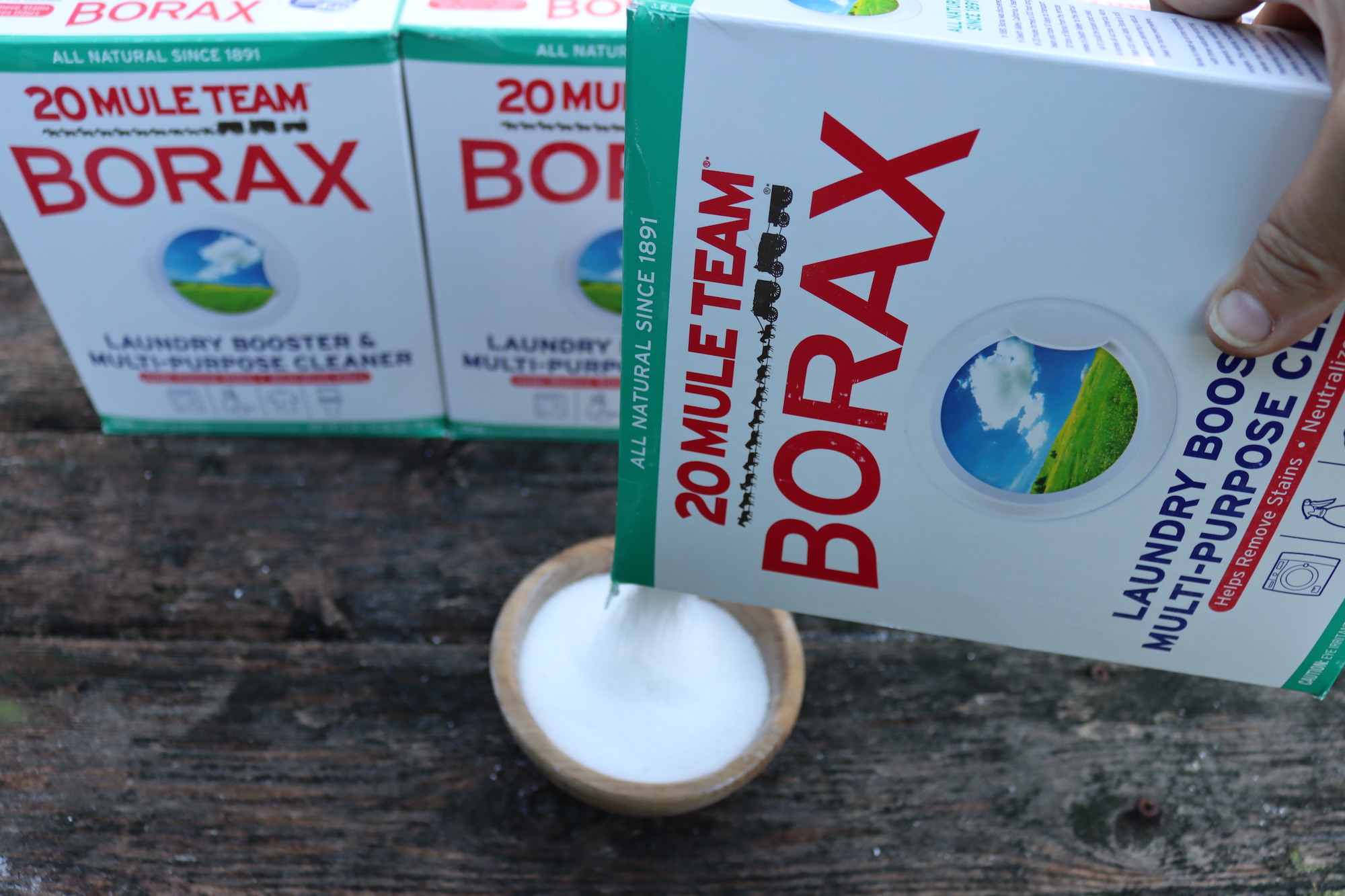
Table of Contents
- What is Borax?
- Uses for Borax
- Borax for Cleaning
- All-Purpose Borax Cleaning Solution
- Wash Windows
- Carpet Cleaner
- Hard Floor Cleaner
- Grout Cleaner
- Clean Car Upholstery
- Remove Crayon or Pen Marks
- Clean Dishwasher
- Dishwasher Booster
- Disposal Cleaner and Clog Remover
- Clean Aluminum Cookware
- Countertop Stain Remover
- Soap Scum and Water-spot Remover
- Toilet Bowl Cleaner
- Toilet Bowl Clog remover
- Fungicide
- Borax for Laundry
- Strip Laundry
- Homemade Laundry Detergent
- Laundry Detergent Booster
- Laundry Brightener and Whitener
- Remove Ink Stains from Fabrics
- Whiten Yellowed Pillows
- Deep Clean Hats
- Wash Plush Animals
- Deodorizing with Borax
- Bathroom Odor Remover
- Refrigerator Refresher
- Freshen Humidifier
- Mattress Deodorizer
- Shoe Deodorizer
- Trash Can Freshener
- Refresh Linens
- Household Uses for Borax
- Control Pool Ph
- Homemade Powdered Hand Soap
- Borax Bar Soap
- Clean Hair Combs and Brushes
- Fireproofing Christmas Trees
- Fireproofing Fabric
- Adhesive Remover
- Rust Remover
- Cockroach Killer
- Bed Bug Killer
- Garden Uses for Borax
- Ant Insecticide
- Woodworm and Wood-fungus Treatment
- Kill Termites
- Herbicide
- Boost for Fruit Trees
- Flower Preservative
- Borax for your Pet
- Borax Crafts and Hobbies
- Borax Crystals
- Frost Pine Cones
- Make Slime
- Green Fire
- Ink for Dip Pens
- Make Candles Burn Longer
- Jewelry Soldering
- Curing Salmon Eggs
- Tanning Hides
- Can You Avoid Borax?
- Useful Lists
Borax is one of those strange powders sold in the laundry aisle of big box stores and supermarkets, but few people know that there are literally dozens of ways to use borax around the home.
It fell out of favor for a while, with the advent of more complex household products that are pre-made and purpose-built, but there was a time when every household and homestead would have borax on the shelf.
Now, with the rise in popularity of homemade slime, many households again have it on the shelf…but few people remember how to use borax (beyond simple modern slime recipes).
Since you only need a teaspoon or so of borax for a big batch of slime, you’ll need the rest of these incredibly practical uses for borax so that big box doesn’t go to waste!
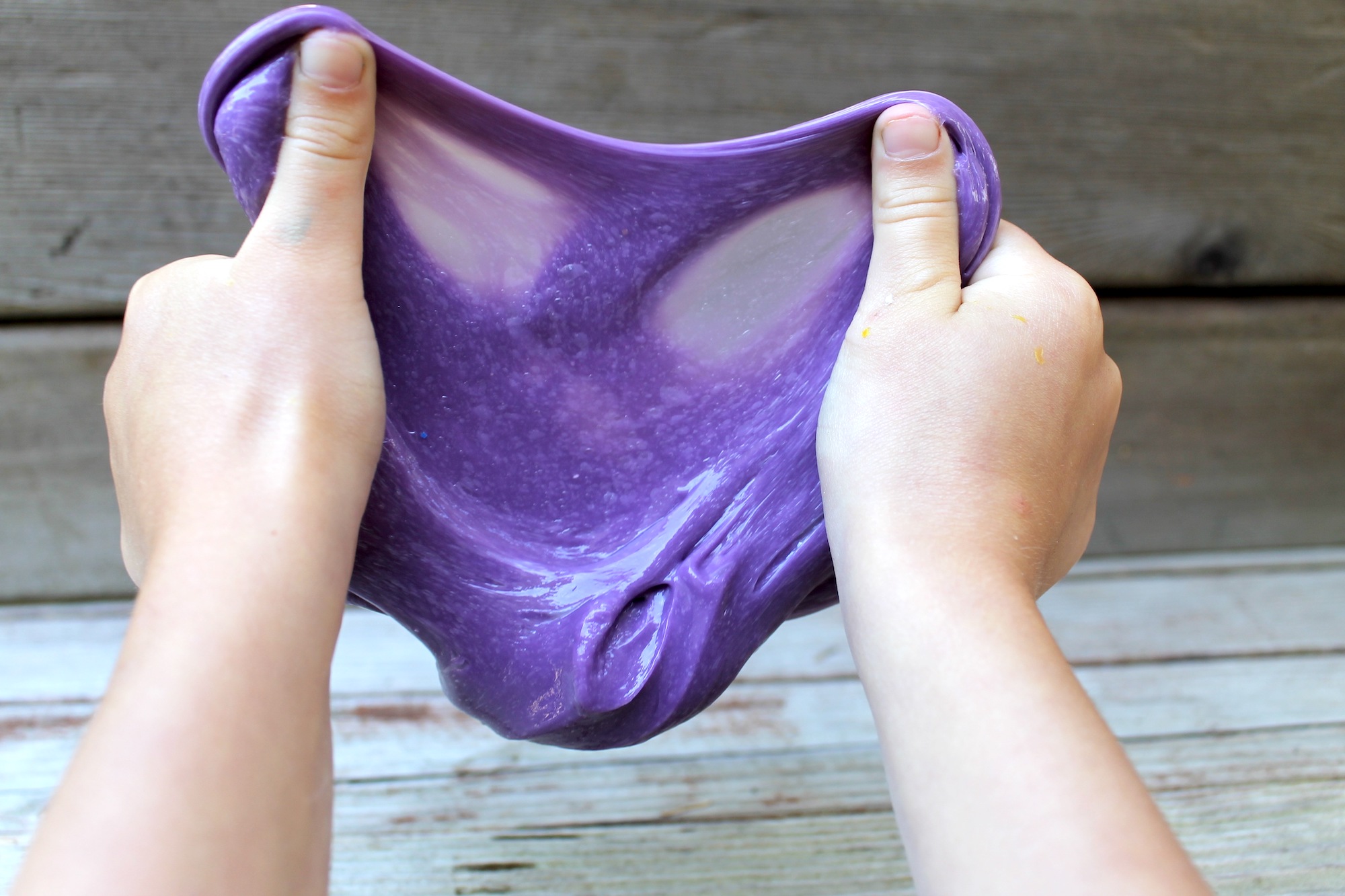
This article is written by Morgan Hyde, a reference librarian from Arizona. Her work for the library has refined her passion for learning and deep research—a passion that began in her rural AZ upbringing. If it’s something she can do on her own, it’s something wants to know about.
What is Borax?
Borax is a colorless, crystalline solid usually sold in a powdered form and found in the laundry aisle of the grocery store. Originally discovered in Tibet and known as Tincal, it began to be traded on the Silk Road as early as the 8th century. Used for laundry, cleaning solutions, and food preservation, Borax didn’t become a common household item until it was popularized by the 20 Mule Team brand in the late 19th century. Even today, this is the most popular source of Borax for households.
Sourced from seasonal lake and river beds, one of the largest sources for Borax is in the dry climate of the Mojave Desert in California. As water in these dry regions evaporates, it leaves behind deposits of Borax. These deposits are then mined and refined through a process known as recrystallization. Raw Borax is dissolved in a solution to remove its impurities, then dried into crystals and powdered.
Chemically known as sodium tetraborate decahydrate, Borax is regularly confused for Boric Acid, a common ingredient in pesticides. The confusion is understandable—after all, you can make Boric Acid from Borax itself and both can be used as insecticides. However, Borax is an alkaline substance and has a higher Ph than Boric Acid. Both contain Boron, but their chemical structures are different. Borax is less toxic than Boric Acid but still can be toxic for children or pets.
There is some concern about the health impact of Borax, including decreased fertility in people exposed regularly to it. As a result, it has been banned as a food additive or preservative in the United States. General guidelines advise to keep it away from your eyes, to use gloves when handling it, and to avoid inhaling or consuming any of the powder. Following these guidelines will allow you to use Borax as safely as you would with any other powerful cleaning agent.
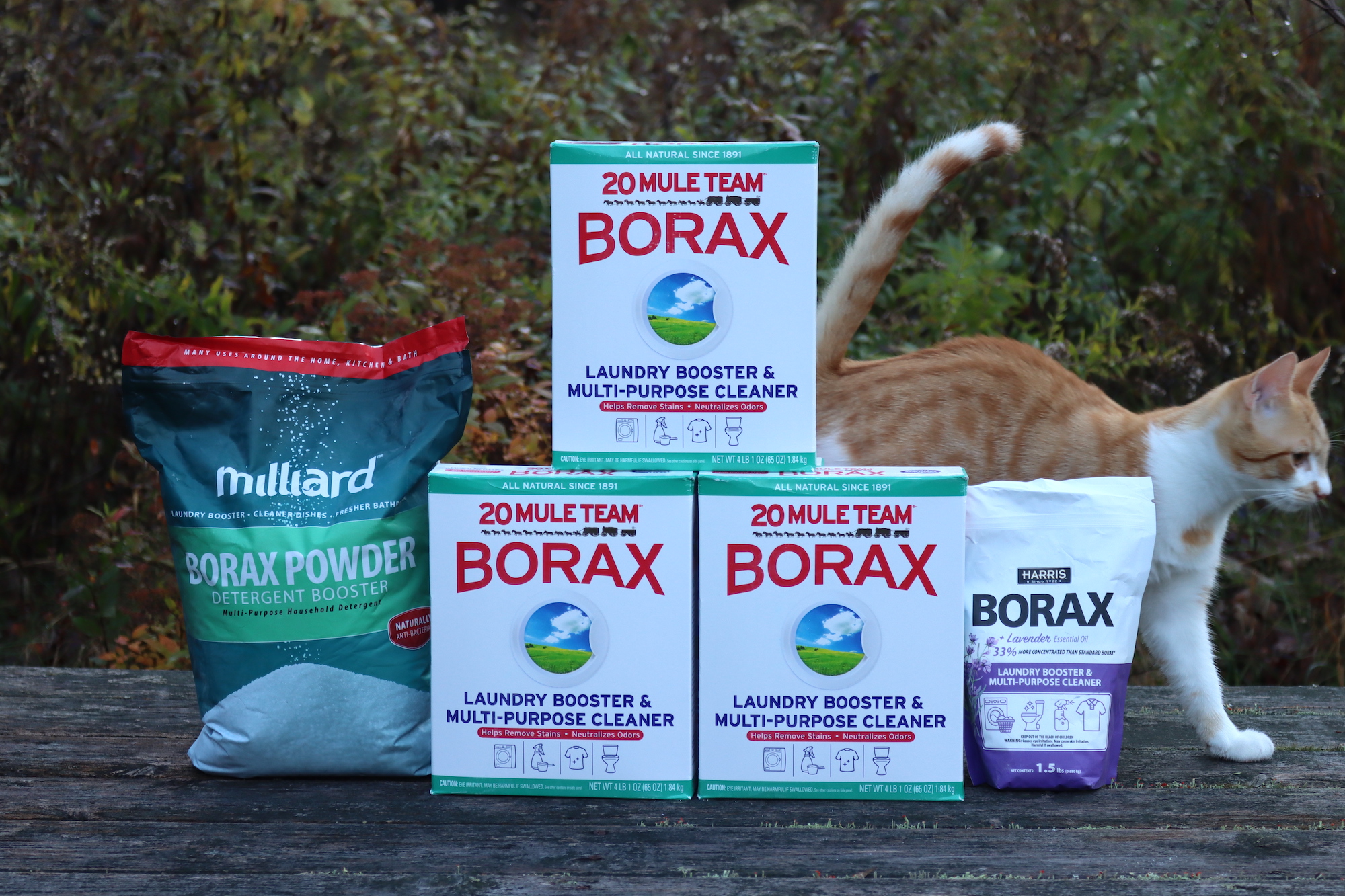
Uses for Borax
Industrially, Borax is used in glazing pottery, as a makeup stabilizer, and to protect ancient paper manuscripts. At home, Borax is an excellent cleaning agent, but it also has some uses for leisure activities!
- Borax for Cleaning
- Borax for Laundry
- Deodorizing with Borax
- Household Uses for Borax
- Garden Uses for Borax
- Borax for Your Pet
- Borax Crafts and Hobbies
I’ll cover each of these uses, one by one.
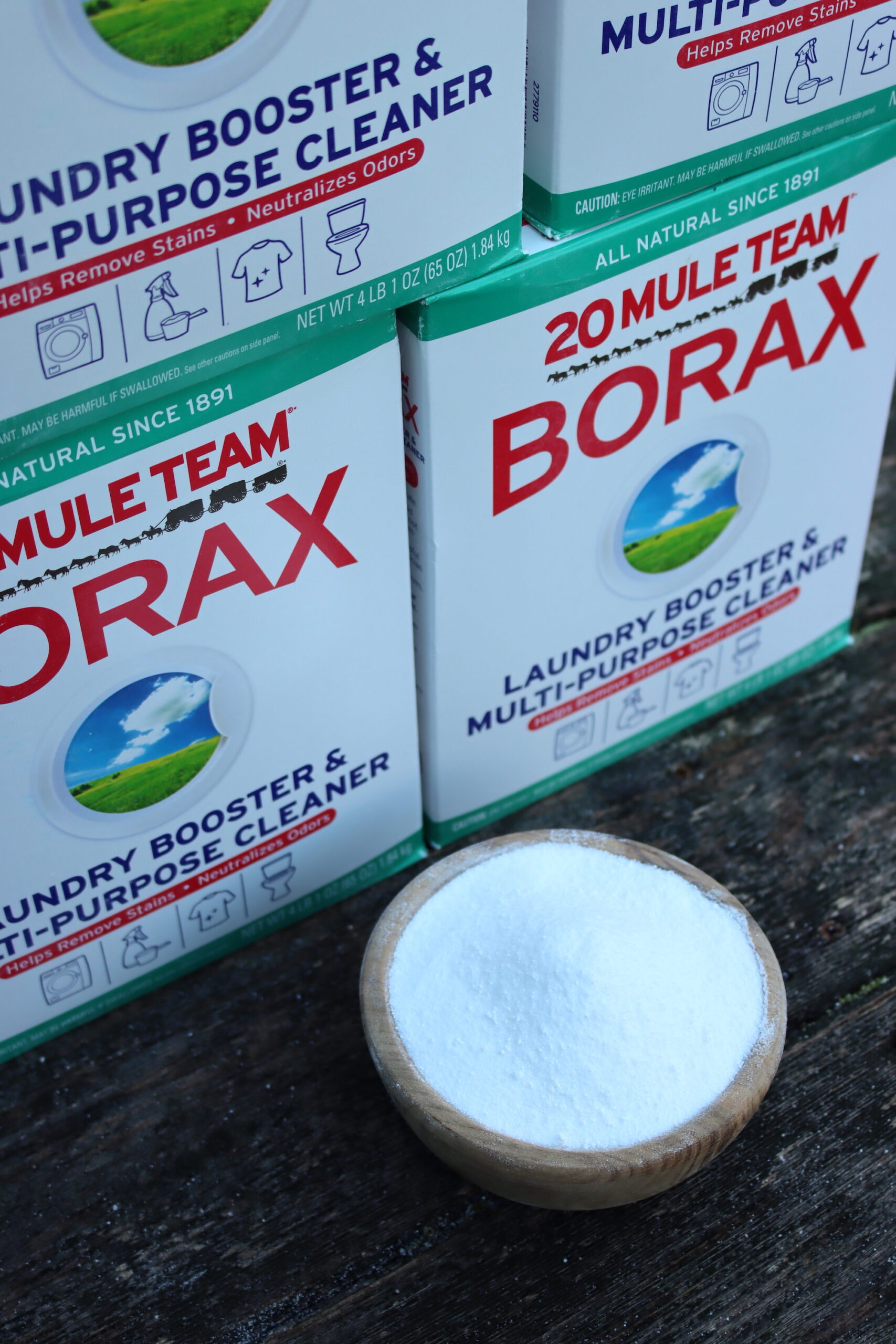
Borax for Cleaning
As a natural disinfectant, Borax is an excellent choice for sanitizing a variety of surfaces. Additionally, it has antifungal properties due to its high Ph and can help cut through thick grime like soap scum.
All-Purpose Borax Cleaning Solution
While there are plenty of ways for you to prepare Borax to use around the house, this solution can be used in place of many of the other cleaning preparations. It’s a great option to mix ahead of time so you can have it on hand, though if it doesn’t seem to be working well, you can easily switch to one of the more specific instructions below.
To make an all-purpose cleaner with Borax, mix ½ cup Borax, 1 ½ cups hot water, 1 tsp dish soap, and 1 tbsp vinegar. Add in essential oils as desired—the solution is going to be mostly odorless, so even lighter scents won’t be overpowered by it. Put the mixture into a spray bottle and use it liberally on any surface. Scrub it in, let it sit for a few minutes, and rinse it off thoroughly.
Wash Windows
My cat enjoys watching the birds through one of the living room windows. Meaning I frequently need to clean the greasy smears off of the glass where he’s smushed his nose into the window. This Borax glass cleaning solution is excellent for cutting through my (unusual) window grime.
In a spray bottle, mix 2 tbsp Borax and 3 cups water. Spritz the windows and use a microfiber cloth to work the solution in. You should see the smears vanishing as you work. Borax acts as a water softener and will prevent any water streaks from forming on your windows.
Carpet Cleaner
Carpets, out of everything in the house, feel like the most time intensive areas to clean. Next time you use a machine carpet cleaner, you can add Borax to the tank to boost the cleaning power and get the most out of your time. Mix in ½ cup of Borax per 1 gallon of water you’ll place in the tank.
For smaller day-to-day spills, you can also use Borax to help absorb the liquid and pull it out of the fibers of your carpet. You’ll begin by blotting the spill and pulling up as much liquid as you can. Then mist the area with cold water and sprinkle Borax on top. Place a towel down and use the back of a spoon to work the Borax in. Take a clean cloth and blot up the area. Once it’s fully dried, vacuum up any remaining Borax.
Hard Floor Cleaner
Living in an area with hard water, it can be frustrating to deal with the streaks left behind after mopping my floors. Borax is a natural water softener and can be used with most cleaning solutions or mixed into a homemade batch to combat the effect of hard water.
To make your own solution, mix 2 tbsp Borax, 1 tbsp castile soap, and 4 tbsp vinegar in a mop bucket and fill it up with water. Mop like normal. If you’re still seeing streaks after mopping, you can increase the amount of Borax in the mixture by ½ tbsp until you’re not seeing them anymore.
Grout Cleaner
Time seems to always take a toll on grout, even with consistent mopping and cleaning. Using Borax, you can bring back the original color of your grout. It’s a mild abrasive but shouldn’t cause any damage. All the same, it’s still a good idea to test it out on a small area first.
To make your own grout cleaner, mix 1 part Borax, 2 parts baking soda, and add in enough vinegar to make a thick paste. Lightly press the mixture onto your grout using gloved fingers or a toothbrush. Leave it for 20 minutes and wipe it away with a damp cloth. Done!
Clean Car Upholstery
Between driving into work and having the occasional car snack, the seats in my car start to look grimy fairly quickly. One way to disinfect and pull out any stains on the interior fabrics in your car is to use Borax.
In a bucket, mix together 3 tbsp of grated Fels-Naptha soap, 2 tbsp Borax, and 2-4 cups of boiling water. You’ll want to use less water and make a more potent solution if you’re dealing with heavy stains and dirt. It will take longer to rinse out, though, so be prepared.
For your seats or any non-removable places, dunk a sponge into the solution and dab it onto the area you want to clean. Let it soak in for a little while and then use a wet cloth to wipe up the solution. I’d recommend having a second bucket of clean water handy to rinse out your wet cloth to speed up the cleaning process.
For floor mats or removable seat covers, pull them out and lay them on a good cleaning area like a patio or sidewalk. Take a scrub brush, dunk it into your solution and scrub away! You can either use a cloth to wipe up the solution, or use a hose to rinse them out. The more water used, the longer it will take to dry.
Remove Crayon or Pen Marks
Kids can get creative and it’s not a far leap to see the similarities between a blank piece of construction paper and an open area of wall. As a mild abrasive with a high Ph, Borax can remove these marks from your walls. You’ll definitely want to test it on an unobtrusive part of your wall first to check its effect on your paint.
Clean up marks on your walls by mixing 1 tbsp Borax with 1 cup water. Use a cloth to smear it in place, soaking the marks. Leave it for 10 minutes and then wipe it away with a damp cloth, scrubbing lightly. Repeat as often as needed to fully remove the stains.
Clean Dishwasher
Being honest, I don’t like looking at the bottom of my dishwasher. I just feel there’s always food bits or murky water lurking down at the bottom. For this reason, and because my dishes go in there, I do try to clean it regularly.
Fully remove your racks (including the top rack, if you can, it makes it much easier). Use a towel to remove any food that’s stuck in the drainage and soak up any standing water. Sprinkle Borax everywhere you can, including the front of the door. Take a stiff brush and dampen it in the sink. Scrub at all surfaces you can comfortably reach. To finish, wipe out the remaining Borax with a damp cloth or replace your racks and run a rinse cycle.
Dishwasher Booster
You can give your dishwasher detergent a little extra power by adding Borax to your normal run cycle. Borax is a natural disinfectant and deodorizer and is a great option if you’re washing some Tupperware that was lurking for too long in your fridge.
You’ll want to sprinkle about a ½ cup’s worth of Borax on the bottom of the dishwasher. Run it like normal with an extra rinse cycle if it’s available.
Disposal Cleaner and Clog Remover
Why buy those disposal cleaning packets when you can make your own cleaning solution at home? The key to any drain cleaning process is having boiling water on hand. Before you heat it up, pour 3 tbsp of Borax down your disposal and let it sit for 15 minutes. Boil your water and dump it down the drain slowly, running the disposal as you do.
If you’re dealing with a clogged drain and water is moving slowly down your disposal, try this: mix 1 cup Borax with 3 cups of boiling water. Pour this down the drain and let it sit for 15-30 minutes (if your sink isn’t draining that slowly, double or triple the amount). You should start to notice the water draining faster while this all sits. Run your disposal until all of the remaining mixture has drained.
Clean Aluminum Cookware
Aluminum goods are notorious for how easily they scratch from basic use. When it comes to daily cleaning, it can be nerve-wracking to put even the rough edge of a sponge to that shiny surface. As a natural disinfectant, Borax is an excellent choice for cleaning aluminum without needing to scrub.
Simply sprinkle Borax onto your dishes and then wipe it away with a damp dish cloth or the soft side of a sponge. Rinse your dishes thoroughly and leave them to air dry.
For tarnished aluminum, make a wet paste with Borax and water. Dip a toothbrush into the paste and dab it onto the tarnish, rinsing your toothbrush when you’re done. Let it sit for an hour or so. Then take the toothbrush and gently scrub at the tarnish—it should come off with minimal effort.
Countertop Stain Remover
Laminate countertops are a low-cost, easily installed option, but maintaining them can be a pain. Leaving anything spilled on the counters overnight seems to leave a permanent stain behind. If you can’t get to a spill quickly enough, you can use Borax to scrub up any marks you see later.
Mix 1 cup Borax and ¼ cup lemon juice or vinegar. Use a sponge to apply the paste to the spot and scrub it in. Rinse the area thoroughly. If scrubbing doesn’t seem to work, try leaving the paste in place for 30 minutes first.
Soap Scum and Water-spot Remover
If you’re looking for a simple bathroom cleaning solution, Borax is perhaps the simplest. Whether you have tile or fiberglass, Borax can help cut through any soap scum buildup and can also address any water spots appearing from hard water.
Sprinkle a damp sponge with Borax and scrub any area you want cleaned. Rinse and dry the area thoroughly. As simple as that!
Toilet Bowl Cleaner
Looking for a toilet cleaner that doesn’t leave behind a harsh chemical smell? Borax is a natural deodorizer and whitener, which may be the perfect combo for the inside of your toilet bowl. Simply pour 1 cup of Borax into the bowl and leave it overnight. In the morning, use a brush to scrub the bowl and flush.
If you prefer a “set it and forget it” method, you can use Borax alone to skip the scrubbing step. Putting a cup of Borax into your toilet’s tank will help combat any rust that has accumulated on the interior. Further, having the Borax in the tank will soften your water and reduce how quickly hard water rings form in your toilet bowl. If you put a cup in your tank and a cup in your bowl before bed a few times a week, your toilet will stay fresh and clean for longer—extending time between scrubbings.
Toilet Bowl Clog remover
Having a plunger on hand is almost a necessity—no one wants to deal with an overflowing toilet without one. In the event you don’t have a plunger, or your plunger needs a little extra help, you can use Borax to loosen up clogs in your toilet.
You’ll need to start by removing some of the water in the bowl (gross, yes, but necessary). Not all of it—half should work just fine to avoid any overspill happening later. Next, take ½ cup of Borax, pour it into the bowl and let it sit for 15 minutes. Put 2 cups of water on to boil and dump it into the toilet. At this stage, if you have a plunger, use it. If not, you can flush and the hot water and Borax should have loosened everything enough to drain properly.
Fungicide
In addition to being a disinfectant, whitener, and deodorizer, Borax can also be used to kill any mold or mildew that might be growing in your house. I’d recommend taking down items you can to lay them flat before cleaning (like shower curtains)—this will keep the solution from sliding off and make scrubbing far easier.
Take a spray bottle and add in ¼ cup Borax and 1 qt warm water, shaking to mix it thoroughly. Spray on any mold and mildew you see and leave it for 15 minutes. Scrub the area with a nylon scrub brush, rinse, and dry completely. For textured ceilings, skip the scrubbing step and rinse off the solution by dabbing the area with a damp cloth.
Using the same solution, you can also prevent mildew or mold from growing in high humidity areas of your house. This is best used on surfaces that aren’t touched often (the ceiling, for example) as you won’t rinse it away. Simply spray the area until it’s thoroughly coated and leave it. Reapply every 3-6 months, depending on the humidity in your area.
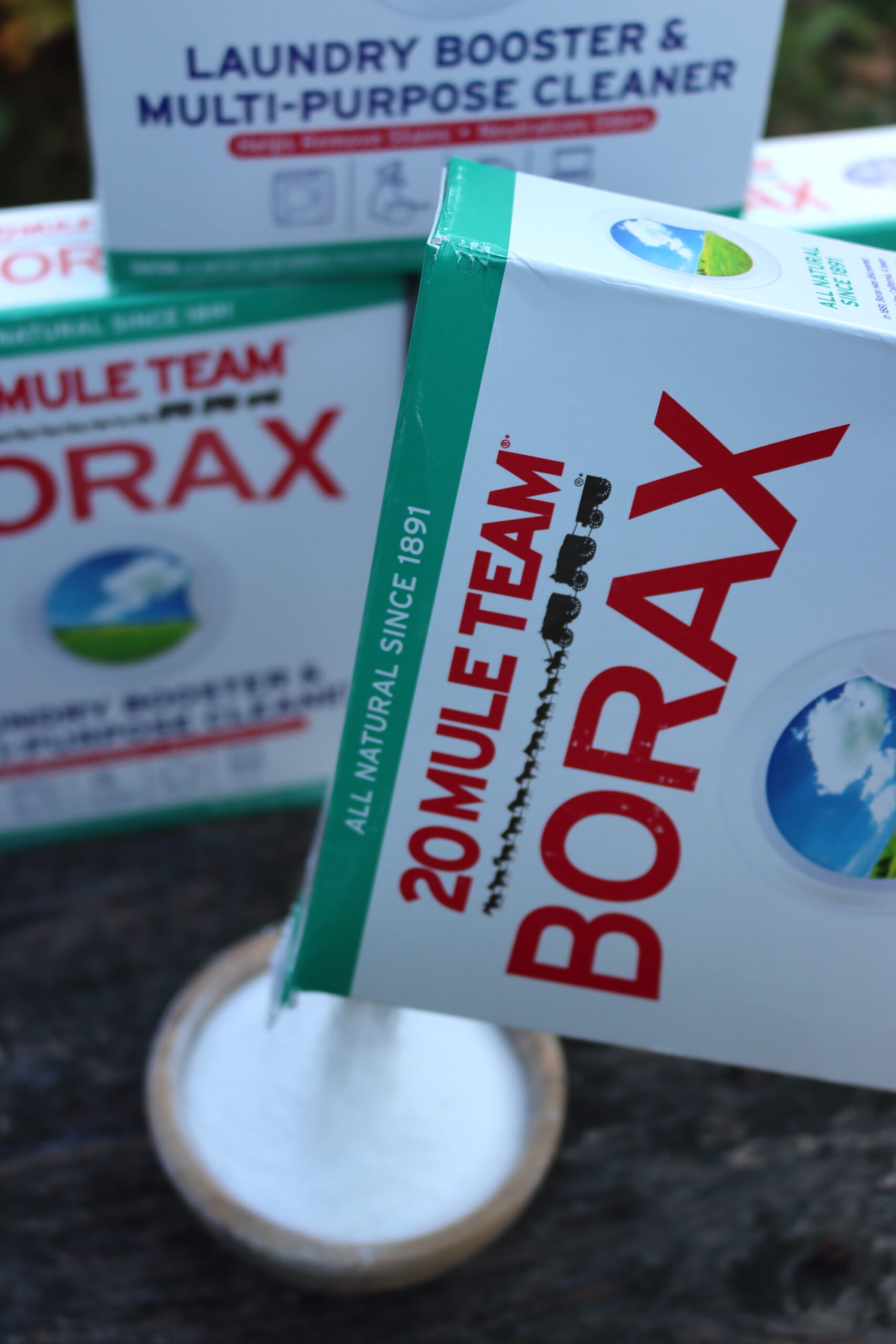
Borax for Laundry
People have been cleaning their clothes with Borax for over a thousand years. It’s an excellent choice for deep cleaning most fabrics and can even brighten your white fabrics. Unlike bleach, however, it won’t alter the color of your clothes and is safe to use on dyed items. Finally, it acts as a water softener that will make your detergent more effective at pulling out grime and dirt.
Strip Laundry
As harsh as the name sounds, stripping your laundry isn’t harmful to your clothes—it’s simply a deep cleaning soak that removes a lot of dirt. You’ll need access to a bathtub for up to 6 hours, so if you don’t have a spare bathroom, consider handling this after everyone has showered for the day.
Fill your bathtub with warm water and add ½ cup Borax, ½ cup washing soda (you also can cook Baking Soda to make washing soda), and ¾ cup laundry detergent for every gallon of water used. For context, a standard bathtub can hold 80 gallons. If you fill it half full, you’ll need to multiply your amounts by 40.
Place everything you want to strip into the water. Soak it for 5-6 hours, stirring it every hour. When done, your water is likely going to look murky. Empty the tub and transfer your clothes to a washing machine and run a normal cycle.
Homemade Laundry Detergent
Tired of buying detergent from the store? You can make your own detergent at home with a few basic ingredients. There are many recipes you can find online to try until you find one that works for you. Below is a basic recipe that makes enough for several loads.
You’ll need 5 oz of a Fels-Naptha laundry bar (usually one whole bar), 3 ¼ cups Borax, 2 cups washing soda, and a ⅔ cup of baking soda. Grate the laundry bar, and add all ingredients together in a large bowl. Pour the mix into an airtight container. As needed, use 2 tbsp of your detergent per load, adding in an extra 1⁄2 tbsp for heavy loads.
Laundry Detergent Booster
If making your own detergent is too time consuming, or you’re generally happy with the one you use, Borax can help add a little extra power to other detergents. It will soften your water (allowing the detergent to do its job well) and help in the disinfecting and brightening process.
To boost your detergent, simply add in ½ cup Borax on top of your clothes, then add your detergent like normal. I’ve found this particularly helpful in the summer to help break up sweat and deodorant stains before they can fully set in.
Laundry Brightener and Whitener
Stripping clothes will accomplish the same goal, but if you’re short on time (or don’t want to use too much water), there’s another way to use Borax to brighten your laundry.
In a bucket or a sink, add ½ cup Borax and 1 gallon of water until you have enough to submerge your items. Leave them in the solution for a full hour. Transfer your laundry over to the washer and run it like normal. For heavily stained items, let them soak for 2 hours before running them in the wash.
Remove Ink Stains from Fabrics
Ink has been an issue for me with my jeans in particular. I like to tuck pens into my pockets or into the folds of my rollups. Then I forget about them and find interesting doodles later. None have ever broken (thank goodness), but for large or small ink stains, Borax can help lift out those marks for you.
In equal parts, mix Borax, dish soap, and water or lemon juice into a paste. Check the care label of all items before starting to make sure the ingredients are safe to use. You’ll then take your paste and rub it into the affected area. Leave it for 30 minutes and then rinse it out thoroughly. The ink should be gone.
Whiten Yellowed Pillows
I have thrown away so many pillows for this issue. Over time, the pillow under the pillowcase always starts to look… an unattractive yellow. It turns out, you can actually correct this discoloration without soaking your pillow in straight bleach.
Remove all covers from your pillow. Bring a large pot of water to a boil, let it cool and dump it into a bucket. Dissolve 1 cup powdered laundry detergent, 1 cup powdered dishwasher detergent, and ½ cup Borax in the water. Add 1 cup of hydrogen peroxide (or bleach) once the powders are dissolved. Let the pillow soak for 30 minutes, flipping it at the halfway mark.
Next, if your pillow is machine washable, place it in the washer and run it on a hot cycle. Dry it in the dryer or out in the sun when finished. For more delicate pillows, you can hand wash them in the sink, using the hottest water you can comfortably handle before letting them air dry.
Deep Clean Hats
Many hats aren’t safe to place in the wash with the rest of your laundry. During the summer, though, they’ll begin to absorb so much sweat and oil they need a thorough cleaning.
Fill a sink with warm water and add 1 tbsp Borax per quart of water. Soak the hat in the sink, shaking it lightly to help the water reach all areas of the hat. After 10-15 minutes of soaking remove the hat and use a toothbrush to scrub any particularly dirty areas. Run clean water over the hat to rinse out the Borax. Shape it into its proper form and let it air dry on a towel.
Wash Plush Animals
Stuffed animals receive a lot of love and pick up a lot of dirt in the process. For any toys able to go in the washing machine, adding Borax to the load will help give them a nice deep clean. Hand wash only toys, though, will take a bit more work.
Fill a sink or bucket with lukewarm water and dissolve 1 tsp laundry detergent plus 1 tsp Borax into it. Dunk the plushie and gently squish it to work the solution in. Massage any particularly dirty or stained areas with your fingers. Let it soak there for 15-60 minutes. As you have time, go back and repeat the squish and massage step.
Dump out the water and refill your container with clean water. Submerge, squish, and massage the stuffed animal to release the suds. Repeat this step, starting with clean water each time until you don’t see any suds coming out when you squeeze the toy. In an empty sink, press down on the stuffed animal to remove some water. Wrap it up in a towel and press it again. Let it air dry on a towel. To avoid matts, wait until it’s damp and use the lowest setting on a hair dryer to fluff it up again.
Deodorizing with Borax
As a dry alkaline substance, Borax helps neutralize any smells caused by moist or acidic substances. This makes it an excellent choice for combating urine or mildew odors among others.
Bathroom Odor Remover
Without getting into details, some parts of the bathroom just smell worse than others. For whatever reason that may be, Borax can be used to both sanitize and deodorize those smelly areas.
Sprinkle a few tablespoons of Borax directly onto the troublesome area. Take a sponge and some warm water and lather the Borax into a thick paste. Leave it for a few hours. If you’re working in an area with a drain, pour boiling water over the Borax to rinse it out. Otherwise, use warm water and a clean cloth to wipe up the rest of the Borax.
Refrigerator Refresher
Unlike using baking soda to deodorize your fridge, Borax as a deodorizer takes a much more active approach. The first thing you’ll want to do is clean up any spills and remove any expired food. Next, mix 1 qt warm water and 1 tbsp Borax. Spray down the shelves, drawers, and walls of your refrigerator. Wipe everything down with a clean wet towel. Your fridge should smell clean by the end.
Freshen Humidifier
During the dry season, humidifiers do an excellent job of keeping your nose and mouth from drying out overnight. When it runs, though, you might notice it has a bit of an unpleasant smell. This could be from a number of causes, but the most likely is mildew. Borax is a natural fungicide and will also help disinfect the interior of your humidifier.
You’ll want to mix together ½ cup of Borax per gallon of water—adjust this ratio to match your humidifier’s max amount. Add this mixture to your tank and run it like normal (preferably outside). When it’s done, rinse your tank out and you’ll be all set!
Mattress Deodorizer
Whether it’s a child’s nighttime accident, a late-night snack spill, or just the result of trying to sleep on hot nights, mattresses can begin to smell a little off. To clean the mattress and remove the smell, you’ll want to start by spritzing the worst areas with water. Sprinkle Borax over the damp spot. Leave it to dry and vacuum it up to complete the process. Done!
Shoe Deodorizer
Keeping a charcoal sachet in your shoe closet can only do so much to combat the smell of stinky shoes. Not all shoes are able to go through a wash cycle, though, so try using Borax to “dry clean” the rest.
The simplest method is to pour a few teaspoons of Borax into each shoe and shake it around. Leave it overnight and dump out the remaining Borax.
For tougher smells, or to clean sandals, put 2 tbsp Borax into a 1 liter spray bottle and fill it up with water. Shake it up right before you use it each time. Spray your shoes down and leave the spray on for 15-20 minutes. Take a soft cloth or a toothbrush and scrub the shoes. Repeat this once a day as often as needed.
Trash Can Freshener
If you’re trying to keep your kitchen smelling fresh, one of the critical things to keep clean is your trash can. Take a generous cup of Borax and dump it into your empty trash can. Fill the can with water and let it sit for an hour. Rinse it out and let it dry. When it’s done, you shouldn’t notice any other smells coming from it. Sprinkle some borax at the bottom to help keep it fresh and you’re done!
Refresh Linens
As linens are cycled in and out of storage each season, you may notice some of your blankets and sheets smelling a little musty. Mildew may be to blame, or it could just be they feel too difficult to clean because they aren’t machine washable. Using Borax, you can gently freshen your linens and remove any smells they’ve accumulated.
Fill a tub, sink, or large bucket with water. For every gallon of water used, add in 8 cups of Borax. Set your items in, agitating them just enough to be fully saturated. Let your linens soak for a few hours. Then rinse them out and let them dry. All musty smells should be gone!
Household Uses for Borax
From use as a pesticide, to fireproofing or specialized cleaning, there are a variety of ways Borax can be used around the house. People with sensitive skin may find Borax highly irritating even in low concentrations—I’d recommend testing some of these methods on a smaller scale first to make sure that you won’t react negatively.
Control Pool Ph
As a water softener, Borax makes for an excellent choice as a Ph controller for your backyard pool. It also acts as a natural fungicide and can help prevent mildew or algae growth. All you’ll need is a Ph testing kit, Borax, and safety gloves.
Check if your Ph is too low—if it’s already high, don’t add the Borax. Based on your pool’s capacity and current alkalinity, calculate how much Borax to add. There are several choices online for calculating your pool capacity (here’s one I found that will also calculate your needed Borax amount).
Turn on the pump and filter, add your Borax to the skimmer, and let everything run for 24 hours. After 24 hours, check your Ph again. Depending on how low your Ph was, you may need to go through the process a few times to reach the ideal range for your pool.
Homemade Powdered Hand Soap
If you don’t enjoy using bars of soap and liquid soap feels too wasteful, you could try making your own powdered hand soap. Many recipes you can find online recommend this as a way to use up the last of your bars of soap. Based on the amounts called for, though, it looks like you’d need to save up several scraps, or adjust the recipes’ ratios.
Whether starting new or old, you’ll first need to start by grating a bar of soap (you’ll need 12oz for this recipe). Set your grated soap in the oven at the lowest temperature. For gas ovens this will be your pilot light. Check on your soap until it’s fully dried and remove it into a cool dish. Take 12 oz grated soap, 9 oz Borax, 6 oz cornmeal, and 1 ⅛ oz sodium perborate and put them all in a blender. Pulse the blender until the mixture looks powdery. Sift it into a bowl and put the chunks back into the blender to keep going.
When everything is fully powdered, place it into a box or a shaker. Sprinkle wet hands with the mixture and lather like normal.
Borax Bar Soap
If soap making has always seemed like an oddly difficult achievement, rest assured, it’s no more complicated than heating and cooling several ingredients. Two different pans and 1 large bowl are required and you’ll want to have them out and on hand before you begin.
Start by dissolving ⅓ cup Borax in ½ cup boiling water. In another pan, melt 2 cups clean rendered tallow and 4 cups coconut oil, then take it off the heat. In a separate bowl, stir ½ cup lye into 2 cups cold water. Pour the lye into the pan with the melted oil and tallow. Add in the Borax solution and stir well. Pour your mixtures into molds and let them cool. You now have your own soap!
Clean Hair Combs and Brushes
While you might clear out the accumulated hair from your combs and brushes when you use them, it’s good to also wash them on a semi-regular basis. Opinions on how often vary from once a week to once a month. Generally, most people seem to agree that if you use a lot of products in your hair, it’s a good idea to clean your combs and brushes with greater frequency. I’d say pick a schedule you can stick to and go from there.
Start by clearing the loose hair from your combs and brushes. I find a paperclip helps with pulling out the small, tightly wound pieces. Next, mix Borax, water, and dish soap in equal parts in a bowl. Soak your hair tools for about an hour and rinse them thoroughly before drying.
Fireproofing Christmas Trees
While the National Christmas Tree Association mentions that water additives aren’t necessary for keeping your tree fresh, the National Forest Service does recommend adding a few things to your tree’s reservoir. Regardless of whether you add to the water or not, the most important fireproofing technique is keeping your tree fully watered.
One common fireproofing recipe is to mix 2 gallons hot water, 2 cups corn syrup, ¼ cup bleach, 2 pinches of Epsom salt, ½ cup Borax, and 1 tsp chelated iron (found in garden stores). Stir everything together in a bucket with a lid. Pour this into your tree’s reservoir as needed to keep it fully watered.
Water additives won’t make your tree completely fireproof, but it should help the tree stay hydrated and resistant to any necessary nearby heat sources.
Fireproofing Fabric
Borax itself can’t be used to put out fires, but it can be used to help make fabric flame resistant. The recipe below can be used to either make your own fire blanket or to treat fabrics that are regularly near high heat or fire. Your fabrics won’t be inflammable, but they’ll be less likely to catch fire.
Mix together 1 gallon of water, 1 cup and 2 tbsp Borax, and ½ cup Boric Acid. Place this in a spray bottle or a bucket big enough for your fabric. Drench the material until your solution is dripping off of it. Let it air dry fully and it should be ready to go!
Adhesive Remover
Some stickers just don’t ever seem to come off—you peel the paper away and are left with an annoyingly tacky glue. But you can easily make a paste out of Borax to scrub the rest away. Mix 2 parts Borax with 1 part water. Dip a toothbrush into the paste and scrub the remaining adhesive off. The dry nature of Borax will cause the adhesive to dry in turn, making it easier to push off of surfaces.
Rust Remover
If you’re looking for a gentle rust remover, Borax based formulas are used to clean rust off of cultural monuments.
You can make an all-materials rust remover with just a little bit of Borax and lemon juice. Mix 1 cup Borax with ½ cup lemon juice. Dab this over the rust and let it sit for a few minutes. Scrub until the rust is gone, rinse, and dry thoroughly.
Cockroach Killer
These bugs are so sneaky, it’s difficult to hunt them down. Outside of calling in a professional, you can use Borax as a homemade cockroach killer. Be careful to make sure to use it in areas your pets and children won’t get into as the Borax will be laying out for some time.
First, identify an out-of-the-way area where cockroaches tend to walk. Sprinkle down a generous amount of Borax. As the cockroaches walk over the Borax it will stick to their feet, ultimately dehydrating and poisoning them. This method is also effective in killing other pests such as boxelder bugs.
If you see a cockroach out in the open and don’t want to smack it with a shoe, you can also spray it with some of the All-Purpose Cleaner from the beginning of this article. It should accomplish the same thing on a smaller scale—the cockroach you sprayed will die. This may be the better option if you can’t find a good place to lay down a lot of the powder.
Bed Bug Killer
Bed bugs are notoriously difficult to eliminate once they’ve settled into a space. Many libraries follow a rigorous process to check for bed bugs in books that have just been returned—once bed bugs get into a book collection, there is almost no way to get them out. I’d recommend checking any second-hand furniture, books, or clothes you receive to avoid letting them in at all.
If they’ve settled in, you’ll want to address them as quickly as possible. Isolate the item (if possible) and liberally sprinkle Borax over any bugs, eggs, or holes that you see. For mattresses or other items that can get wet, liberally spray them down with water until the Borax is damp– this will help suffocate the bed bugs. It can take up to a week for the bed bugs to be fully killed off. This may seem like an impossibly long time to wait, but it is absolutely worth it to stop an infestation from spreading.
Garden Uses for Borax
While not as versatile as it is in the house, Borax can help you out around the garden. From pest and weed control, to preserving flowers, here are a few ways you can use it:
Ant Insecticide
As with most homemade ant poisons, this recipe is going to call for sugar. You’ll want to make sure to sprinkle it directly over the ant hole so the ants collect it all quickly. Keep your children away from the area and consider keeping any curious pets inside.
To make the ant poison, mix ¼ cup sugar, 1 cup warm water, and 1 tsp Borax. Crumble over any anthills in your yard.
Woodworm and Wood-fungus Treatment
Any wood kept outside is liable to start breaking down after a while. Whether it’s a fence or your children’s sandbox, there are ways for you to prevent extra damage from coming to its timbers. This recipe is specific to woodworm and wood-fungus and isn’t meant to weatherproof your wood.
First make sure your wood surfaces are dry and clean of oil or grease. Mix ⅔ cup Borax with 1 liter water. Brush, dip, or evenly spray your timber, making sure your solution is getting into the grain of your wood. Let it dry for 24 hours and apply a second coat. Any wood that comes in contact with the ground should be sealed with paint or varnish after the second coat has dried. This will prevent rain or sprinklers from leaching the Borax out of the wood.
Kill Termites
Just like with any pest infestation, it’s important to address the issue as quickly as possible. If you notice any signs of termites (including swarmers, discarded wings, pinholes in drywall, hollowed or damaged wood, etc.), you’ll want to treat it right away. Borax is a home solution you can use to kill termites before they cause too much damage.
Dissolve 1 tsp Borax per 1 cup of water you’ll use. Spray into infested soil or saturate affected wood surfaces. As termites move and eat in these environments, they’ll carry the solution back to their nests and poison the whole colony. Additionally, you can fill cracks in your timber with Borax powder for a similar effect and keep any more termites from entering that space.
Herbicide
Salts are highly effective at removing unwanted plants from an area. Be careful with choosing them as your weed killer: if you’re putting enough down to kill unwanted plants you will also harm others nearby. Borax is a salt, and while the Boron element in it can be beneficial to plants, too much will act as a weed killer.
Simply sprinkle a generous amount of Borax over any weeds you want to kill. Driveway and sidewalk cracks are some of the best areas for this method. Over time the Borax will help prevent new plants from settling into those areas.
Boost for Fruit Trees
In addition to your usual care routine for your plants, adding a small amount of Borax to the soil can help support fruit development in trees. Trees that produce fruit can become deficient in Boron over time (this is especially true of apple trees). Borax includes Boron as one of its main elements and can be used as an occasional fertilizer.
Whether using Borax or another Boron supplement, you want to avoid adding too much to your soil. Excessive Boron can make your fruit toxic. It’s recommended to sprinkle a few tablespoons of Borax at the base of your fruit trees no more than once every 3 years. If you’re seeing your fruit cracking or showing signs of corking, it may be time to add Borax and set a reminder to add more in a few years.
Flower Preservative
Gardeners or anyone who has a bouquet they’ve loved might be interested in drying those flowers to enjoy for even longer. Just letting them air dry tends to change the color and shape of the petals. Using Borax, you can dry them to look beautiful for longer.
Take a small container and mix equal parts cornmeal and Borax. Submerge thin petaled flowers (like roses) completely and seal the box. After a few weeks, your flowers will be perfectly dried! Be aware that flowers dried with Borax aren’t edible any longer, so it’s not a recommended method for any flowers you want to dry for later use in teas or baking.
Borax for your Pet
Caring for pets means making their environment comfortable (both for them and for you). Whether it’s smells, fleas, or mange, you can use Borax to help keep your pets happy.
Stain and Odor Remover
Some of the other stain and odor removing methods from earlier in this article will work just as well for cleaning up after your pet. For urine accidents, though, you may want to try this pet-specific method: mix equal parts Borax, salt, and vinegar together. Blot the area dry and add the paste, working it in with gloved hands or the back of a spoon. Leave it alone for 30-45 minutes.
While it’s soaking, it would be a good idea to block off the area so your pet doesn’t try investigating your cleaning solution. Once it’s dried, vacuum up the powder and sponge up any remnants. You shouldn’t need to worry about any smells or stains lingering behind. For particularly large stains, you may need to follow this method a second time after the area has dried.
Treating Mange
As an insecticide, Borax is an effective treatment for mange. I’d recommend finding a non-Borax solution for cats and any dogs that have a habit of grooming themselves. While the concentration of Borax in this method should be low enough to avoid toxicity, by consistent licking your pet may ingest enough to cause digestion issues.
Mix 1 cup hydrogen peroxide with 2 cups water and add in 2 tbsp Borax. Shampoo your dog normally, rinsing all the suds out, and then apply the solution. Make sure to thoroughly soak the worst areas of mange. Do not rinse off your pet—let them air dry to give the Borax time to kill the mites. Reapply the treatment 3-4 times per week.
Kill Fleas
If your pet has picked up fleas, you’ll want to remove the pests from your house in addition to killing the ones living in their fur. After starting a treatment plan for your pet, if you can, isolate any items that might have fleas nesting in them: bedding, carpets, etc. Liberally sprinkle Borax over the surfaces until they’re covered. Let it sit for an hour and then vacuum up the powder. This should kill any eggs and damage the young fleas. Repeat the cleaning daily until you no longer see signs of fleas.
Borax Crafts and Hobbies
From crystals and slime to making green fire or ink, there are a variety of things you can use Borax for in creative activities. You don’t need to be an advanced craftsperson for this either—many of these activities are suitable for kids.
Borax Crystals
Part fun, part science experiment, you can grow crystals at home using Borax and water. Each crystal you grow will be clear and colorless. You can add in some color using bright pipe cleaners to form a base or by adding a few drops of food coloring to your water.
Start by boiling 3 cups of water and dissolving in ¾ cup Borax, ¼ cup at a time. If the water is starting to look cloudy, stop adding Borax. Pour this solution into jars or bowls. Tie a piece of string to a pencil. If using pipe cleaners, tie them to the other end of the string and bend them into the shape you’d like your crystals to be.
Dunk the string (and pipe cleaner) into the water and leave it for 12-24 hours. Longer soaking time will mean bigger crystals in the end, though you’ll want to make sure they don’t get too big to fit through your jar mouths. When done, remove them from the water and let them dry.
Frost Pine Cones
Want your pine cones to look like they’ve been left out in the snow and ice? Use some Borax to grow clear “icy” crystals on them.
Start by boiling water and adding it to a jar or bowl big enough for 1 pinecone. Stir in Borax 1 teaspoon at a time until it stops dissolving fully. Submerge your pinecone and weigh it down with a rock or other weight to help keep it from floating. After a few hours, you can remove the weight as the pinecone will be waterlogged enough to stay down.
Leave the pinecone overnight and remove it the next day. There should be some crystals growing on it. Like with growing crystals alone, you can change the color of your pinecone’s “ice” by adding in some food coloring to the boiling water.
Make Slime
Fun, squishy, rubbery, slime is an easy at-home project your kids can do to make their own toys. I’d recommend this for older kids who won’t put the slime or their slimed hands into their mouths. The Borax concentration is very low in this recipe, but caution is still recommended.
Slime is made by mixing 4 oz school glue (often a full bottle’s worth), ½ cup water, and a few drops of food coloring. In another bowl, mix 1 tsp Borax with 1 cup warm water. Pour the glue mix into the Borax and stir. You’ll know it’s done when all ingredients are fully melded together.
Green Fire
Different elements burn with different colors. The classic example of this being driftwood burning blue from the metal salts it’s absorbed. Borax, when burned, turns fire green from the Boron in its makeup.
For a fun project, you can also make your own “driftwood” out of Borax to turn your fireplace green. Dissolve Borax in water until the water is saturated. Soak a few pinecones or another piece of wood in the water for a few hours. Remove and let them dry completely. They are now ready to be tossed into the fireplace!
Ink for Dip Pens
Enjoyers of calligraphy or block stamps will find they can make their own inks at home using a variety of materials. One recipe that uses Borax to make a dark, indelible ink comes from a method recorded in 1872:
Take 18oz water, add 1 oz powdered Borax, and 2 oz bruised shellac, place them in a covered pot and boil them. Stir occasionally, boiling until everything is dissolved. Filter the mixture into a bowl and return it to the pot. Add 1 oz mucilage (a type of plant-based glue) and boil for a few more minutes, adding in powdered indigo and lampblack until it reaches a color you want. Take it off the heat and leave it for 2-3 hours to let the remaining clumps break up. Pour it into a bottle or jar, filtering the dregs as you go, and seal for later use.
Make Candles Burn Longer
Unfortunately, this won’t work for any luxury candles you’ve purchased.
Homemade candles, however, can be set up to burn more slowly by soaking the wick in 1 tbsp salt, 2 tbsp Borax, and ¾ cup of water. Borax is a natural fire retardant and will make it harder for the wick to burn down. Additionally, wicks soaked in Borax will be less smoky as they burn.
Jewelry Soldering
In the world of jewelry soldering, Borax is used as a flux to help the solder flow, prevent the metal from oxidizing, and avoid the risk of fire stains. Commonly sold in a cone and dish form, there are also recipes you can find for making your own powdered or liquid flux out of Borax.
Take 1 cup Borax, 1 cup potash, and ½ cup salt. Mix them thoroughly and store the powder in a sealed jar. From here, you can use it dry, or add just enough water to form a paste.
Curing Salmon Eggs
Borax can be used to turn eggs from a freshly caught female salmon into bait. You’ll need to start with a prepared skein (butterflied, with all the blood removed) and wear gloves at all times while handling the salmon.
Mix together 3 parts Borax, 2 parts sugar, and 1 part non-iodized salt. Take your prepared skein and cover the eggs with the powdered cure, massaging it in to make sure all eggs are fully coated. Cut your skeins into chunks, choosing a size that works best for you. Place the chunks into a zippered bag and add in more of the cure. Tumble the eggs and the cure in the bag.
Place your bag into the fridge for 24 hours. Every few hours try to tumble the bag a little more. Once the 24 hours are up, you’re free to add any color or scents you’d like. Keep it in the fridge for another 24-48 hours, and your eggs will be ready to fish with!
If your eggs feel a little soupy, add a bit of Borax to them the night before fishing to help firm them up. Cured eggs can be stored in vacuum-sealed jars or bags in the freezer for up to a year.
Tanning Hides
Tanning soaks benefit from added Borax by creating a safe soaking environment through the increased alkalinity of the water. Borax can also be used to strip out vegetable-crust tans to finish the tanning process or to prepare leather for re-tanning.
A ratio of 5-15lbs of Borax per 1000 gallons of water used is recommended for creating your tanning soak. Before adding your pelt to your tanning container, make sure it has been fully scraped and salted.
Once it has soaked in the Borax solution for at least 2 hours, remove the pelt and squeeze out as much water as you can. Pin down the hide, fur side down, and make a paste out of 4 oz Borax, 4 oz alum, and a little water. Spread this over your hide and massage it in. Leave the paste on for a day and rinse out, letting the pelt hang until it’s nearly dry. It should now be ready for the stretching and oiling process.
Can You Avoid Borax?
It’s kind of amazing just how many ways borax is used in our modern world, even though you rarely see it. If it wasn’t for the rise in natural homemade cleaners in the past decade, and the recent obsession with homemade slime in the past few years, most modern households wouldn’t even know about borax.
Still, whether you know about it or not, borax is incredibly useful around the house, in the garden, and in handicrafts.
It’s been used since ancient times, and it’s still in heavy use in modern times as well. Odds are, there’s borax in something you’re using just about everyday.
Useful Lists
Looking for other ways to use common household items?
- 70+ Uses for Wood Ash
- 40+ Uses for Spent Coffee Grounds
- 70+ Practical Uses for Baking Soda
- 100+ Uses for Apple Cider Vinegar
